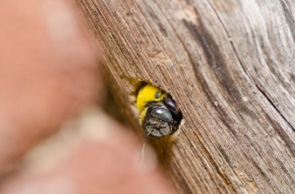CARPENTER BEES CONTROL
Carpenter bees rarely attract homeowner’s attention, especially because they might be confused with other types of bees or they are not even noticed. These bees are one of the primary wood-damaging insects in the US; therefore, their activities can cause extensive damage to wooden structures, including your home.
Not sure if you have a carpenter bee problem? Or maybe you want to learn more about how carpenter bee control works. Check out the following information to clarify some questions you may have.

WHAT ARE CARPENTER BEES?
Carpenter bees are a large specie of bees that get their common name due to their habit of boring into wood around properties; even though they can cause damage to the properties, carpenter bees are beneficial to plants because they pollinate the ones that are ignored by honeybees. There are seven different species of carpenter bees across the United States and their physical features may vary slightly, this is why they can easily be confused with other types of bees.
Carpenter bees are not social insects; they do not live in colonies like honeybees or bumble bees, they build their nests just for themselves and only feed their own young. They also overwinter individually; usually in previously constructed brood tunnels. The ones that survive the winter will emerge and mate the following spring, when fertilized female carpenter bees will work nonstop excavating into wood in order to make a tunnel to lay their eggs.
HOW TO IDENTIFY CARPENTER BEES OR BUMBLE BEES?
As mentioned before, carpenter bees can easily be confused with other types of bees, especially with bumble bees. These two types look very similar; both are quite large, almost 1 inch long and their shape and coloring are also very similar. The main physical difference between these two types of bees is their abdomens. Bumble bees have a hairy abdomen with black and yellow stripes, while carpenter bees have shiny and hairless abdomen.
Even though carpenter bees and bumble bees are similar in appearance, they are actually different in habits and lifecycles. As mentioned before carpenter bees are solitary, only a single pair and their eggs share the nest, whereas bumble bees live in a colony sharing the nest with many other bees. Another nesting difference between these two bees is where they nest; bumble bees nest underground, while carpenter bees make tunnels into wood to make their nests. These two are the main behavior differences that can help you identify whether you have carpenter bees or bumble bees
WHAT CAUSES CARPENTER BEE INFESTATIONS?
Carpenter bees are a common wood destroying insect in New Jersey. Even though they do not eat wood, they still can cause damage by excavating tunnels inside wood in order to build their nests. These tunnels are usually bore softwood like pine and cedar as well as weathered wood, so if you have wood around your property, you may be exposed to a carpenter bee problem. If a carpenter bee problem is not taken care of, they may continue using and even expanding the same tunnels or making new ones.
HOW TO IDENTIFY A CARPENTER BEE INFESTATION?
Carpenter bee infestations are easy to identify, look for the following signs to determine if you are having a problem with this pest:
- Perfectly round and smooth dime-sized entrance holes in wood, which is the only visible part of the nest.
- Presence of sawdust on the ground under or near the area where the hole is drilled.
- Threatening flight activity around the area by males defending the territory.
- Presence of a yellowish substance near or inside the entrance, which can be pollen and feces.
WHAT MAY CARPENTER BEES IN OR AROUND YOUR PROPERTY CAUSE?
Carpenter bees are fairly harmless; males appear aggressive due to their flying around people and pets, but they are not harmful since they do not have a stinger, on the other hand females do have a stinger but will only use it if bothered. Even though they are not harmful, these bees are a serious property threat that can cause structural damage to properties.
The holes carpenter bees create may seem small on the outside, but the galleries in the inside are much bigger than meets the eye, which is why they can cause serious damage to your property. These galleries are made by the female in order to lay 6 to 8 eggs in them, they start with a tunnel that follows a straight path for a few inches, then she turns sharply 90-degrees and the tunnel can extend for several feet to their chambers. Female carpenter bees can repeatedly bore holes throughout the property and would rather return to previously constructed tunnels and enlarge them, increasing the damage to the wood. Their nests are usually in the eaves of homes, in decks, siding, fascia boards or porches.
Besides the damage carpenter bees can cause to wooden structures, the presence of carpenter bees oftentimes can attract woodpeckers, which would create more extensive damage to the existing holes made by the bees. As you can see if carpenter bees are left untreated you may have a worse problem in the future.

TIPS FOR HOMEOWNERS
Getting rid of carpenter bees requires a specific treatment but homeowners can prevent an infestation. Here are some tips to make your property less ideal for a carpenter bee invasion:
- Keep an eye out for bee activity in wooden areas in your property, most common areas are eaves, wood shingles, window and door trim, fascia boards, porches, decks, swing sets, wood railings, and fence posts.
- Painting or varnishing susceptible wood is one of the best controls since it makes wood less attractive and adds an extra layer of protection.
- Check for signs of previous carpenter bee infestations, the treatment can prevent them from reemerging in the spring.
- Replace wood with PVC trim or railings, or wrap fascia boards with vinyl or aluminum siding for a permanent control of carpenter bees.
- Plug up carpenter bee holes once the bees have vacated the gallery. You can use plugs, putty or caulk to plug up the holes.
- Don’t fill in or paint over carpenter bee holes without having them treated previously.
- Cover exterior openings to your home, you can use fine mesh screens or caulk for small crevices to prevent bee incursions.
WHAT WILL WE DO?
At E&G Pest Solutions, we offer both extermination and preventive services to assist in the early detection and elimination of carpenter bees in your property. The process typically consists of the following stages:
- Confirm or discard the existence of carpenter bees on the premises through an inspection
- Identify the factors that may be causing and contributing to the infestation.
- Offer pest control programs to get the problem under control.
- Treat the existing carpenter bee population with either dust or liquid chemical; we would also prevent future infestations by sealing the holes once the bees are gone.
Want a Free Estimate?
Need to Schedule Service?
Have a Questions?
WHY CHOOSE E&G PEST SOLUTIONS?
- All of our services are guaranteed. We deliver what we promise or your money back,
- We were chosen business leader of the year in Middlesex County, member of Home Advisor and Angie’sList.
- We offer unique and effective pest solutions
- We are environmentally conscious
- We provide termite inspection reports for real estate transactions.
What our clients are saying
Our Partners and Awards
Service Areas
New Jersey:
Ocean County
Essex County
Passaic County
Morris County
Hudson County
Bergen County









